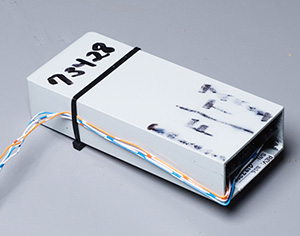
 Readers of this blog may recall that in the Fall of 2005, my graduate students (Micah Sherr, Eric Cronin, and Sandy Clark) and I discovered that the telephone wiretap technology commonly used by law enforcement agencies can be misled or disabled altogether simply by sending various low-level audio signals on the target's line [link our full pdf paper here]. Fortunately, certain newer tapping systems, based on the 1994 CALEA regulations, have the potential to neutralize these vulnerabilities, depending on how they are configured. Shortly after we informed the FBI about our findings, an FBI spokesperson reassured the New York Times that the problem was now largely fixed and affects less than 10 percent of taps [link].
Readers of this blog may recall that in the Fall of 2005, my graduate students (Micah Sherr, Eric Cronin, and Sandy Clark) and I discovered that the telephone wiretap technology commonly used by law enforcement agencies can be misled or disabled altogether simply by sending various low-level audio signals on the target's line [link our full pdf paper here]. Fortunately, certain newer tapping systems, based on the 1994 CALEA regulations, have the potential to neutralize these vulnerabilities, depending on how they are configured. Shortly after we informed the FBI about our findings, an FBI spokesperson reassured the New York Times that the problem was now largely fixed and affects less than 10 percent of taps [link].
Newly-released data, however, suggest that the FBI's assessment may have been wildly optimistic. According to a March, 2008 Department of Justice audit on CALEA implementation [pdf], about 40 percent of telephone switches remained incompatible with CALEA at the end of 2005. But it may be even worse than that; it's possible that many of the other 60 percent are vulnerable, too. According to the DoJ report, the FBI is paying several telephone companies to retrofit their switches with a "dial-out" version of CALEA. But as we discovered when we did our wiretapping research, CALEA dial-out has backward compatibility features that can make it just as vulnerable as the previous systems. These features can sometimes be turned off, but it can be difficult to reliably do so. And there's nothing in the extensive testing section of the audit report to suggest that CALEA collection systems are even tested for this.
By itself, this could serve as an object lesson on the security risks of backward compatibility, a reminder that even relatively simple things like wiretapping systems are difficult to get right without extensive review. The small technical details matter a lot here, which is why we should always scrutinize -- carefully and publicly -- new surveillance proposals to ensure that they work as intended and don't create subtle risks of their own. (That point is a recurring theme here; see this post or this post, for example.).
But that's not the most notable thing about the DoJ audit report.
It turns out that there's sensitive text hidden in the PDF version of the report, which is prominently marked "REDACTED - FOR PUBLIC RELEASE" on each page. It seems that whoever tried to sanitize the public version of the document did so by pasting an opaque PDF layer atop the sensitive data in several of the figures (e.g., on page 9). This is widely known to be a completely ineffective redaction technique, since the extra layer can be removed easily with Adobe's own Acrobat software or by just cutting and pasting text. In this case, I discovered the hidden text by accident, while copying part of the document into an email message to one of my students. (Select the blanked-out subtitle line in this blog entry to see how easy it is.) Ironically, the Justice Department has suffered embarrassment for this exact mistake at least once before: two years ago, they filed a leaky pdf court document that exposed eight pages of confidential material [see link].
This time around, the leaked "sensitive" information seems entirely innocuous, and I'm hard pressed to understand the justification for withholding it in the first place (which is why I'm comfortable discussing it here). Some of the censored data concerns the FBI's financial arrangements with Verizon for CALEA retrofits of their wireline network (they paid $2,550 each to upgrade 1,140 older phone switches; now you know).
A bit more interesting was a redacted survey of federal and state law enforcement wiretapping problems. In 2006, more than a third of the agencies surveyed were tapping (or trying to tap) VoIP and broadband services. Also redacted was the fact that that law enforcement sees VoIP, broadband, and pre-paid cellular telephones as the three main threats to wiretapping (although the complexities of tapping disposable "burner" cellphones are hardly a secret to fans of TV police procedurals such as The Wire). Significantly, there's no mention of any problems with cryptography, the FBI's dire predictions to the contrary during the 1990s notwithstanding.
But don't take my word for it. A partially de-redacted version of the DoJ audit report can be found here [pdf]. (Or you can do it yourself from the original, archived here [pdf])
The NSA has a helpful guide to effective document sanitation [pdf]; perhaps someone should send a copy over to the Justice department. Until then, remind me not to become a confidential informant, lest my name show up in some badly redacted court filing.
Addendum, 16 May 2008, 9pm: Ryan Singel has a nice summary on Wired's Threat Level blog, although for some reason he accused me (now fixed) of being a professor at Princeton. (I'm actually at the University of Pennsylvania, although I suppose I could move to Princeton if I ever have to enter witness protection due to a redaction error).
Addendum, 16 May 2008, 11pm: The entire Office of the Inspector General's section of the DoJ's web site (where the report had been hosted) seems to have vanished this evening, with all of the pages returning 404 errors, presumably while someone checks for other improperly sanitized documents.
Addendum, 18 May 2008, 2am: The OIG web site is now back on the air, with a new PDF of the audit report. The removable opaque layers are still there, but the entries in the redacted tables have been replaced by the letter "x". So this barn door seems now to be closed.
Photo above: A law enforcement "loop extender" phone tap, which is vulnerable to simple countermeasures by the surveillance target. This one was made by Recall Technologies, photo by me.